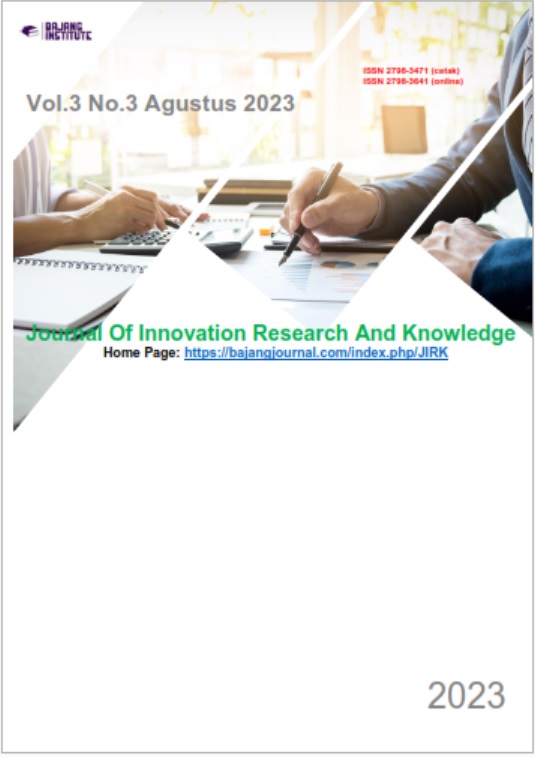ANALISIS MISKONSEPSI SISWA KELAS VIII MATERI SISTEM GERAK MANUSIA di MTsN 9 BOYOLALI TAHUN PELAJARAN 2022/2023
DOI:
https://doi.org/10.53625/jirk.v3i3.6137Keywords:
CRI, Miskonsepsi, Sistem Gerak Pada ManusiaAbstract
Background: Misconceptions, namely understanding of a concept individually but the concept captured is different from the actual concept. Research Objectives The aim of this study was to find out the misconceptions of class VIII students on the subject of the human movement system using CRI at MTsN 9 Boyolali in the 2022/2023 academic year. Research Method: This type of research is qualitative research using a descriptive method, because it is used to describe and explain the misconceptions of class VIII students at MTsN 9 Boyolali in 2022/2023 without any treatment using the Certainty of Response Index (CRI) scale in solving multiple choice test questions and essay. Research Results: The results of this study were that there was a misconception in sub-indicator number 16 of 90% and was expressed with a high level of misconception. The main cause of misconceptions that occur in the material concept of the human movement system is the condition of the students, or comes from the students themselves. Conclusion: Conclusion: namely that there is a misconception that occurs in class VIII students on the human movement system material at MTsN 9 Boyolali in the 2022/2023 academic year using the Certainty Of Response Index (CRI) method with the percentage of the average value of misconceptions in class VIII in the category Do not understand concepts (TPK) of 72.45%, Misconceptions (M) of 60.4% and Understanding of Concepts (PK) of 15%. Overall, according to the data above, it can be concluded that there are still student misconceptions with a percentage of 60.4%.
References
A’yun, Q., & Nuswowati, D. M. (2018). Analisis Miskonsepsi Siswa Menggunakan Tes Diagnostic Multiple Choice Berbantuan Cri (Certainty of Response Index). Jurnal Inovasi Pendidikan Kimia, 12(1), 2108–2117.
Afriliska, N., Zulyusri, Z., Padang, U. N., & Padang, K. (2021). Meta-analisis Miskonsepsi Buku Teks pada Materi Biologi SMA Pendahuluan Metode. 3(1), 21–31.
Dwi, I. V., Rahayu, Y. S., & Erman. (2013). Penerapan Pendekatan Contextual Teaching and Learning (CTL) untuk Mengatasi Miskonsepsi Siswa SMP pada Materi Fotosintesis. Jurnal Pendidikan Sains e-Pensa, 1 (2), 21-29.
Hariyadi Dedy, Ibrohim, & Rahayu Sri. (2016). Pengaruh Model Pembelajaran Inkuiri Terbimbing Berbasis Lingkungan Terhadap Keterampilan Proses dan oenguasaan konsep IPA. Jurnal Pendidikan: Teori, Penelitian, Dan Pengembangan, 1(8), 1567–1574.
Hidayat, F. A., Irianti, M., & Faturrahman. (2020). Analisis Miskonsepsi Siswa dan Faktor Penyebabnya pada Pembelajaran Kimia di Kabupaten Sorong. Jurnal Inovasi Pembelajaran IPA, 1(1), 1–8.
Irianti, E. (2021). Identifikasi Miskonsepsi Siswa Pada Materi Cahaya Menggunakan Four Tier Diagnostics Test. Jurnal Pendidikan Fisika Undiksha, 11(2), 1–10.
Kose, S. (2008). Diagnosing Student Misconceptions: Using Drawings as A Research Method. World Applied Sciences Journal, 3 (2), 283- 293.
Siyoto, S., & Sodik, M. A. (2015). Dasar Metodologi Penelitian. http://library1.nida.ac.th/termpaper6/sd/2554/19755.pdf
Suparno, P. (2013). Miskonsepsi dan Perubahan Konsep dalam Pendidikan Fisika. Jakarta: PT Grasindo.
Widarti, H. R., Permanasari, A., & Mulyani, S. (2016). Student misconception on redox titration (A challenge on the course implementation through cognitive dissonance based on the multiple representations). Jurnal Pendidikan IPA Indonesia, 5(1), 56–62.















